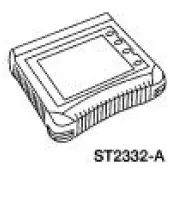Ford Mustang (1999-2004) Service Manual: Evaporative Emission Repair Verification Drive Cycle
Special Tool(s)
 |
Worldwide Diagnostic System (WDS) 418-F224, New Generation STAR (NGS) Tester 418-F052, or equivalent scan tool |
Drive Cycle Recommendations
NOTE: The following procedure is designed to execute and complete the evaporative emission repair verification drive cycle and to clear the Ford P1000, inspection and maintenance (I/M) readiness code.
When the ambient air temperature is below 4.4C (40F) or above 37.8C (100F), or the altitude is above 2,438 meters (8,000 feet), the EVAP monitor will not run. If the P1000 must be cleared in these conditions, the powertrain control module (PCM) must detect them once (twice on some applications) before the EVAP monitor can be bypassed and the P1000 cleared. The EVAP bypassing procedure is described in the following drive cycle.
1. Most OBD II monitors will complete more readily using a steady foot driving style during cruise or acceleration modes. Operating the throttle in a smooth fashion will minimize the time necessary for monitor completion.
2. Fuel tank level should be between one-half and three-quarters full with three-quarters full being the most desirable.
3. The evaporative monitor can only operate during the first 30 minutes of engine operation. When executing the procedure for this monitor, stay in part throttle mode and drive in a smooth fashion to minimize fuel slosh.
Drive Cycle Preparation
NOTE: For best results, follow each of the following steps as accurately as possible.
4. NOTE: This step bypasses the engine soak timer and resets OBD II monitor status.
Install the scan tool. Turn the key ON with the engine OFF. Cycle the key off, then on. Select the appropriate vehicle and engine qualifier. Clear all diagnostic trouble codes (DTCs) and carry out a PCM reset.
5. Begin to monitor the following PIDs: ECT, EVAPDC, FLI (if available) and TP MODE. Press Diagnostic Data Link, PCM, PID/Data monitor and record, press trigger to select each PID, then start.
6. Start the engine without returning the key to the OFF position.
Preparation for Monitor Entry
WARNING: Strict observance of posted speed limits and attention to driving conditions are mandatory when proceeding through the following drive cycle.
7. NOTE: This step allows engine warm-up and provides intake air temperature (IAT) input to the PCM.
Idle the vehicle for 15 seconds. Drive at 64 km/h (40 mph) until the ECT is at least 76.7C (170 F).
8. Is IAT above 4.4C (40F) and below 37.8C (100F)? If not, continue with the following steps but note that the EVAP Monitor Bypass portion of the drive cycle (Step 13) will be required to bypass the EVAP monitor and clear the P1000.
9. NOTE: This step executes the heated oxygen sensor (HO2S) monitor.
Cruise at 64 km/h (40 mph) for 60 seconds.
10. NOTE: This executes the EVAP monitor if IAT is above 4.4C (40F) and below 37.8C (100F).
NOTE: To initiate the monitor, TP MODE should equal PT, EVAPDC must be greater than 75%, and FLI must be between 15 and 85%.
NOTE: Avoid sharp turns and hills.
Cruise at 72 to 104 km/h (45 to 65 mph) for 10 minutes.
11. NOTE: This step executes the ISC portion of the Secondary Air/CCM.
Bring the vehicle to a stop. Idle with the transmission in DRIVE (for automatic transmission) or NEUTRAL (for manual transmission) for two minutes.
Pending Code and EVAP Monitor Bypass Check
12. NOTE: This determines if a pending code is preventing the clearing of P1000.
NOTE: If the EVAP monitor is not complete and IAT was below 4.4C (40F) or above 37.8C (100F) temperature range in Step 8, or the altitude is above 2,438 meters (8,000 feet), the EVAP Monitor Bypass (Step 13) must be carried out.
Using the scan tool, check for pending codes. Conduct normal repair procedures for any pending code concerns. Rerun any incomplete monitor.
EVAP Monitor Bypass
13. NOTE: This allows the bypass counter to increment to two.
NOTE: Do not repeat Step 4.
Park the vehicle for a minimum of eight hours. Repeat Steps 5 through 12.
 Evaporative Emission System Leak Test
Evaporative Emission System Leak Test
Special Tool(s)
Evaporative Emission System
Tester 310-F007
(134-00056) or equivalent
Worldwide Diagnostic System
(WDS)
418-F224,
New Generation STAR (NGS)
Tester
...
 Evaporative Emission Canister
Evaporative Emission Canister
Removal and Installation
1. WARNING: The evaporative emission system contains fuel vapor
and condensed
fuel vapor. Although not in large quantities, it still presents the
danger of explosion ...
Other materials:
Electronic compass
The compass heading displays in the center-integrated display.
Note: Driving near large buildings, bridges, power lines and powerful
broadcast antenna may affect the compass reading. Magnetic or metallic
objects placed in, on or near your vehicle may also aff ...
Bumpers
Torque Specifications
Bumpers
CAUTION: Never apply excessive heat to the bumper cover surface. Heat
could cause
distortion of the bumper cover.
The bumper systems consist of the following components:
front bumper
front bumper cover
front bumper cover (Co ...
Installation
CAUTION: Electronic modules are sensitive to static electrical
charges. If exposed to
these charges, damage may result.
1. NOTE: Two technicians are necessary to carry out this step.
Install the instrument panel.
2. Install the upper instrument pa ...
